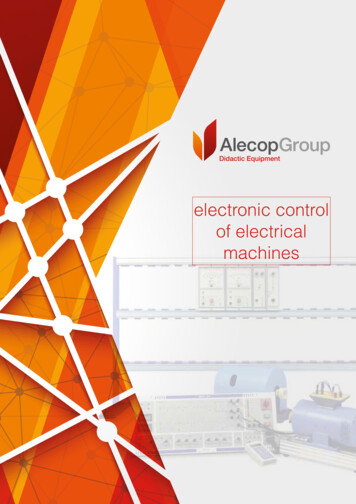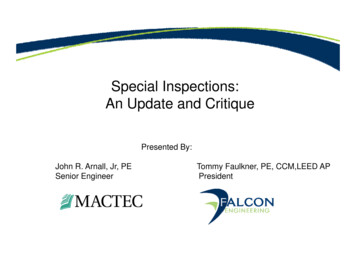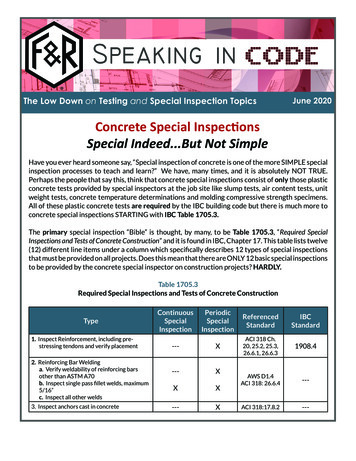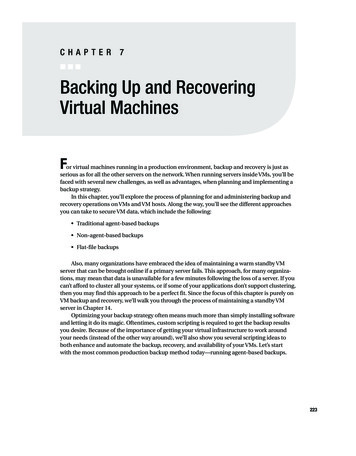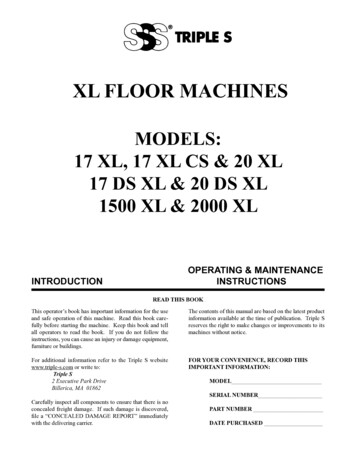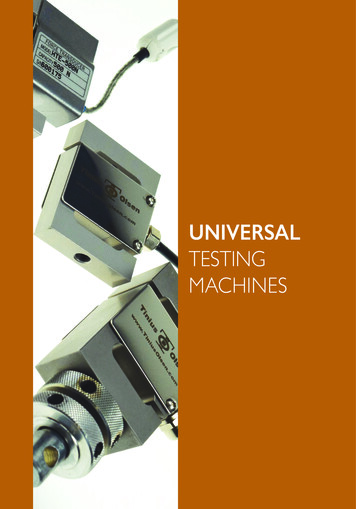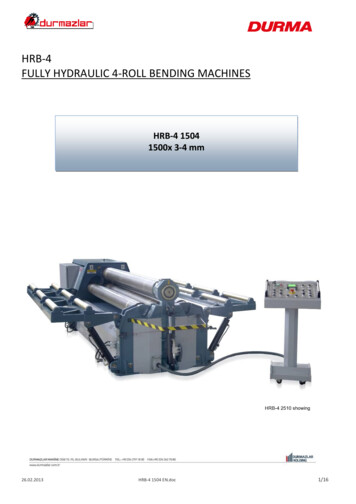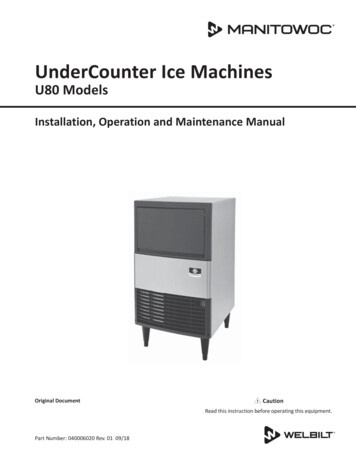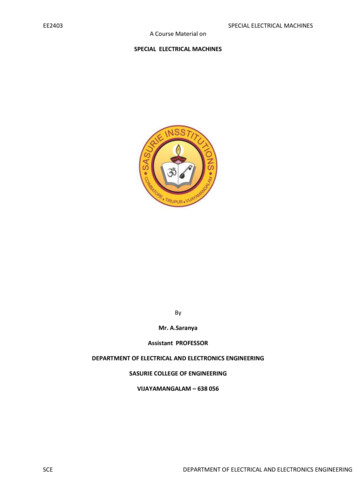
Transcription
EE2403SPECIAL ELECTRICAL MACHINESA Course Material onSPECIAL ELECTRICAL MACHINESByMr. A.SaranyaAssistant PROFESSORDEPARTMENT OF ELECTRICAL AND ELECTRONICS ENGINEERINGSASURIE COLLEGE OF ENGINEERINGVIJAYAMANGALAM – 638 056SCEDEPARTMENT OF ELECTRICAL AND ELECTRONICS ENGINEERING
EE2403SPECIAL ELECTRICAL MACHINESQUALITY CERTIFICATEThis is to certify that the e-course materialSubject Code: EE2403Subject : SPECIAL ELECTRICAL MACHINESClass: IV Year EEEbeing prepared by me and it meets the knowledge requirement of the university curriculum.Signature of the AuthorName:Designation:This is to certify that the course material being prepared by Mrs. A.Saranya is of adequate quality.She has referred more than five books among them minimum one is from aboard author.Signature of HDName: S.SRIRAMSEALSCEDEPARTMENT OF ELECTRICAL AND ELECTRONICS ENGINEERING
EE2403SPECIAL ELECTRICAL MACHINESS.NOCONTENTPAGENOUNIT I SYNCHRONOUS RELUCTANCE MOTORS1.1Construction Of Synchronous Reluctance Motor81.2Rotor design1.2.1 Salient rotor (Segmental)11111.2.2 Radially Laminated Rotor (Flux Barrier)1.2.3 Axially Laminated Rotor11121.3Rotor construction121.4Working of synchronous reluctance motor131.5Primary design considerations11.6Torque – speed characteristics151.7Phaser diagram of synchronous reluctance motor161.8Advantages and disadvantages of srm191.9Applications of synchronization191.1Vernier motors191.10.1Principle of operation201.10.2 Air – Gap permeance Distribution201.10.3 Design of Vernier Motor21Glossary23UNIT - II STEPPING MOTOR2.1Introduction252.2Classification of stepper motors252.3Single stack variable reluctance stepper motor262.3.1 Construction262.3.2 Electrical Connection262.3.3 Principle of Operation27Micro stepping control of stepping motor302.4.1 Principle of micro stepping312.5Multistack variable reluctance stepper motor322.6. Hybrid stepper motor332.7Claw tooth pm motor342.8Single phase stepping motor352.8.1 Construction362.8.2. Principle of Operation362.4SCEDEPARTMENT OF ELECTRICAL AND ELECTRONICS ENGINEERING
EE2403SPECIAL ELECTRICAL MACHINES2.9Theory of torque prediction362.12.10 terminologies used in stepper motor402.112.11. Characteristics of stepper motor412.11.1. Static characteristics422.11.2. Dynamic characteristics432.12Torque-speed characteristics442.13Figures of merit fm'sDrive system and control circuitry for stepper motor452.14.1 Drive System472.14.2 Logic Sequencer482.14.3. Power Driver Circuit2.14.4 Improvement of current buildup/special driver circuit492.1447512.15Linear And Non Linear Analysis562.16Application Of Stepper Motor59Glossary62UNIT III SWITCHED RELUCTANCE MOTOR3.1Introduction633.2Construction and operation of srm633.2.1 Construction of SRM633.2.2 Block Diagram Of SRM643.2.3. Principle of operation653.3Power semiconductor switching circuits for srm (power controllers)663.3.1 Two Power Semiconductor Switching Devices per phase and two66 diodes663.3.2 (n 1) power switching devices and (n 1) diodes65673.3.3 Phase winding using bifilar wires683.3.4 Split – link circuit used with even phase number693.3.5 C-Dump circuit70Voltage and torque equations of srm713.4.1 Basic voltage equation of SRM723.5Control circuits for srm733.6Hysterisis type current regulation743.7Voltage pwm type current regulation753.8Torque-speed characteristics763.8.1 Torque Speed Capability Curve773.43.9SCEDistinction between switched reluctance motor and the variable reluctance steppermotor77DEPARTMENT OF ELECTRICAL AND ELECTRONICS ENGINEERING
EE2403SPECIAL ELECTRICAL MACHINES3.9.1 Merits of SRM773.9.2 Demerits of SRM783.9.3 Application of SRM783.1Shaft position sensing783.11Microprocessor or computer based control of Srm drive79Glossary81UNIT IV PERMANENT MAGNET BRUSHLESS D.C. MOTORS4.14.1 Introduction824.24.2 Constructional feature of BLPM motors824.2.1 Construction824.2.2 Merits and Demerits834.2.3 Comparison of brushless dc motor relative to induction motor drives834.2.4 Commutator and brushes arrangement844.2.5 Construction of Mechanical Commutator844.2.6 Mechanical Commutator and Brushes Arrangement844.2.7 Electronic Commutator4.2.8 Comparison between mechanical Commutator and brushes and electronicCommutatorB – h loop and demagnetization characteristics854.3.1 Permanent Magnets Material884.3.2 B – H Loop894.3.4 Demagnetization curve894.4Principle of operation of brushless pm dc motor904.5Classification of BLPM dc motor914.6Emf equation of BLPM SQW dc motors924.7Basic voltage equation of BLPMDC motor954.8Torque equation of BLPM square wave motor974.9Torque- speed characteristics of BLPM SQM dc motor984.1Commutation in motors with 120 and 180 magnet arc1004.11Magnetic circuit analysis on open circuit1064.12A controller for BLPM SQW dc motor1084.12.1 Power Circuit1084.12.2 Control circuit1094.12.3 Hall Effect Position Sensor111Types of BLPM motor1114.13.1 One phase winding one pulse BLPM motor1124.13.2 One phase two pulse BLPM motor1124.34.13SCE8788DEPARTMENT OF ELECTRICAL AND ELECTRONICS ENGINEERING
EE2403UNITVSPECIAL ELECTRICAL MACHINES4.13.3 Two phase winding and two pulse BLPM motor1134.13.4 Three phase winding and three pulse BLPM motor1144.13.5 Three phase six pulse BLPM S5.1Introduction1185.2Construction and principle of operation1185.3Emf equation of BLPM sine wave motor1215.3.1 Flux density distribution1215.3.2 EMF Equation of an ideal BLPM sine wave motor1225.3.3 EMF equation of practical BLPM sine wave motor123Torque equation of BLPM sine wave motor1245.4.1 Ampere conductor density distribution1245.4.2 Torque equation of an ideal BLPM sine wave motor1265.4.3 Torque developed in a practical BLPM SNW motor1285.5Phasor diagram of a brushless pm SNW or BLPB synchronous motor1315.6Permissible torque-speed characteristics1375.7Vector control of BLPM SNW motor1385.7.1 Principle of vector control1395.7.2 Schematic Diagram of Vector Control139Self control of PMSM1405.8.1 Inner current and outer speed loop1415.8.2 Commutation at low speed1415.8.3 Four Quadrant Operations141Microprocessor based control of PMSM142Glossary144Question Bank1505.4.5.85.9SCEDEPARTMENT OF ELECTRICAL AND ELECTRONICS ENGINEERING
EE2403SPECIAL ELECTRICAL MACHINESEE2403SPECIALELECTRICALMACHINESAIMTo expose the students to the construction, principle of operation and performance ofspecial electrical machines as an extension to the study of basic electrical machines.OBJECTIVESTo impart knowledge oni. Construction, principle of operation and performance of synchronous reluctance motors.ii. Construction, principleofoperation, controlandperformanceofstepping motors.iii. Construction, principle of operation, control and performance of switched reluctancemotors.iv. Construction, principle of operation, control and performance of permanent magnetbrushless D.C .motors.v. ermanentmagnetsynchronousmotors.UNITI ELMotors–VoltageandTorqueEquationsPhasordiagram - l features–Principle of operation–Variable reluctance motor –Hybrid motor–Single and multi itations–Characteristics–Drive circuits–Microprocessor control of stepping motors–Closed loop onal features–Rotary and Linear SRMs-Principle of operation–Torque production–Steady state performance prediction-Analytical method-Power Converters and theircontrollers – Methods of Rotor position sensing – Sensor less operation – Closed loopcontrol of SRM- MOTORS 9Permanent Magnet materials– Magnetic Characteristics –Permeance coefficient-Principle ofoperation–Types–Magnetic circuit analysis–EMF and torque equations –CommutationPower controllers–Motor characteristics and control.UNITVPERMANENTMAGNETSYNCHRONOUSMOTORS 9Principle of operation–Ideal PMSM –EMF and Torque equations–Armature reaction MMF–Synchronous Reactance – Sine wave motor with practical windings - Phasordiagram – Torque/speed characteristics- Power controllers- Converter Volt-ampererequirements.TOTAL:45 PERIODSTEXT BOOKS:1. T.J.E.Miller,‗Brushless Permanent Magnet and Reluctance Motor Drives‘, ClarendonPress, Oxford, 1989.2. T.Kenjo,‗Stepping Motors andTheir Microprocessor Controls‘, Clarendon Press uctanceMotor lication‘,CRCPress,NewYork,2001.SCEDEPARTMENT OF ELECTRICAL AND ELECTRONICS ENGINEERING
EE2403SPECIAL ELECTRICAL oMotor TheoryandPractice‘,PeterPerengrinusLondon, rushlessDCMotors‘,ClarendonPress,London, 1988.SCEDEPARTMENT OF ELECTRICAL AND ELECTRONICS ENGINEERING
EE2403SPECIAL ELECTRICAL MACHINESUNIT ISYNCHRONOUS RELUCTANCE MOTORS1.1 CONSTRUCTION OF SYNCHRONOUS RELUCTANCE MOTORThe structure of reluctance motor is same as that of salient pole synchronous machine asshown in fig. The rotor does not have any field winding .The stator has three phasesymmetrical winding, which creates sinusoidal rotating magnetic field in the air gap, and thereluctance torque is developed because the induced magnetic field in the rotor has a tendencyto cause the rotor to align with the stator field at a minimum reluctance positionFig 1.1 Idealized Three Phase Four Pole Synchronous Machine (Salient Pole)Fig 1.2 Cross Section of Synchronous Reluctance Motor.The rotor of the modern reluctance machine is designed with iron laminations in the axialdirection separated by non-magnetic material. The performance of the reluctance motor mayapproach that of induction machine. With high saliency ratio a power factor oh 0.8 can bereached. The efficiency of a reluctance machine may be higher than an induction motorSCEDEPARTMENT OF ELECTRICAL AND ELECTRONICS ENGINEERING
EE2403SPECIAL ELECTRICAL MACHINESbecause there is no rotor copper loss. Because of inherent simplicity, robustness ofconstruction and low cost.The synchronous reluctance motor has no synchronous starting torque and runs upfrom stand still by induction action. There is an auxiliary starting winding. This has increasedthe pull out torque, the power factor and the efficiency.Synchronous reluctance motor is designed for high power applications. It can broadly beclassified intoAxially laminated andRadially laminated.Fig.1.3 cross section of axially laminatedReluctance motors can deliver very high power density at low cost, making them ideal formany applications. Disadvantages are high torque ripple (the difference between maximumand minimum torque during one revolution) when operated at low speed, and noise caused bytorque ripple. Until the early twenty-first century their use was limited by the complexity ofdesigning and controlling them. These challenges are being overcome by advances in thetheory, by the use of sophisticated computer design tools, and by the use of lowcost embedded systems for control, typically based on microcontrollers using controlalgorithms and real-time computing to tailor drive waveforms according to rotor position andSCEDEPARTMENT OF ELECTRICAL AND ELECTRONICS ENGINEERING
EE2403SPECIAL ELECTRICAL MACHINEScurrent or voltage feedback. Before the development of large-scale integrated circuits thecontrol electronics would have been prohibitively costly.Fig 1.4 cross section of radially laminatedThe stator consists of multiple projecting (salient) electromagnet poles, similar to awound field brushed DC motor. The rotor consists of soft magnetic material, such aslaminated silicon steel, which has multiple projections acting as salient magnetic polesthrough magnetic reluctance. The number of rotor poles is typically less than the number ofstator poles, which minimizes torque ripple and prevents the poles from all aligningsimultaneously—a position which cannot generate torque.When a rotor pole is equidistant from the two adjacent stator poles, the rotor pole issaid to be in the "fully unaligned position". This is the position of maximum magneticreluctance for the rotor pole. In the "aligned position", two (or more) rotor poles are fullyaligned with two (or more) stator poles, (which mean the rotor poles completely face thestator poles) and is a position of minimum reluctance.When a stator pole is energized, the rotor torque is in the direction that will reducereluctance. Thus the nearest rotor pole is pulled from the unaligned position into alignmentwith the stator field (a position of less reluctance). (This is the same effect used by a solenoid,or when picking up ferromagnetic metal with a magnet.) In order to sustain rotation, thestator field must rotate in advance of the rotor poles, thus constantly "pulling" the rotor along.Some motor variants will run on 3-phase AC power (see the synchronous reluctance variantbelow). Most modern designs are of the switched reluctance type, becauseelectronic commutation gives significant control advantages for motor starting, speed control,and smooth operation (low torque ripple).SCEDEPARTMENT OF ELECTRICAL AND ELECTRONICS ENGINEERING
EE2403[SPECIAL ELECTRICAL MACHINESDual-rotor layouts provide more torque at lower price per volume or per mass.The inductance of each phase winding in the motor will vary with position, because thereluctance also varies with position. This presents a control systems challenge.Applications Some washing machine designs. Control rod drive mechanisms of nuclear reactors. The Dyson Digital Motor used in some products produced by the Dyson company.1.2 ROTOR DESIGN1.2.1 Salient rotor (Segmental)Salient rotor shape such that the quadrature air gap is much larger than the direct air gap. Thisyields reactively small Ld/Lqrations in the range of 2.3.Fig.1.5 Salient rotorSalient rotor design is as shown
EE2403 SPECIAL ELECTRICAL MACHINES SCE DEPARTMENT OF ELECTRICAL AND ELECTRONICS ENGINEERING 3.9.1 Merits of SRM 77 3.9.2 Demerits of SRM 78 3.9.3 Application of SRM 78 3.1 Shaft position sensing 78 3.11 Microprocessor or computer based control of Srm drive 79 Glossary 81 UNIT IV PERMANENT MAGNET BRUSHLESS D.C. MOTORS

